Jingyu Hu
Mitigating Degree Bias Adaptively with Hard-to-Learn Nodes in Graph Contrastive Learning
Jun 05, 2025Abstract:Graph Neural Networks (GNNs) often suffer from degree bias in node classification tasks, where prediction performance varies across nodes with different degrees. Several approaches, which adopt Graph Contrastive Learning (GCL), have been proposed to mitigate this bias. However, the limited number of positive pairs and the equal weighting of all positives and negatives in GCL still lead to low-degree nodes acquiring insufficient and noisy information. This paper proposes the Hardness Adaptive Reweighted (HAR) contrastive loss to mitigate degree bias. It adds more positive pairs by leveraging node labels and adaptively weights positive and negative pairs based on their learning hardness. In addition, we develop an experimental framework named SHARP to extend HAR to a broader range of scenarios. Both our theoretical analysis and experiments validate the effectiveness of SHARP. The experimental results across four datasets show that SHARP achieves better performance against baselines at both global and degree levels.
Fine-Grained Interpretation of Political Opinions in Large Language Models
Jun 05, 2025Abstract:Studies of LLMs' political opinions mainly rely on evaluations of their open-ended responses. Recent work indicates that there is a misalignment between LLMs' responses and their internal intentions. This motivates us to probe LLMs' internal mechanisms and help uncover their internal political states. Additionally, we found that the analysis of LLMs' political opinions often relies on single-axis concepts, which can lead to concept confounds. In this work, we extend the single-axis to multi-dimensions and apply interpretable representation engineering techniques for more transparent LLM political concept learning. Specifically, we designed a four-dimensional political learning framework and constructed a corresponding dataset for fine-grained political concept vector learning. These vectors can be used to detect and intervene in LLM internals. Experiments are conducted on eight open-source LLMs with three representation engineering techniques. Results show these vectors can disentangle political concept confounds. Detection tasks validate the semantic meaning of the vectors and show good generalization and robustness in OOD settings. Intervention Experiments show these vectors can intervene in LLMs to generate responses with different political leanings.
HypoBench: Towards Systematic and Principled Benchmarking for Hypothesis Generation
Apr 15, 2025Abstract:There is growing interest in hypothesis generation with large language models (LLMs). However, fundamental questions remain: what makes a good hypothesis, and how can we systematically evaluate methods for hypothesis generation? To address this, we introduce HypoBench, a novel benchmark designed to evaluate LLMs and hypothesis generation methods across multiple aspects, including practical utility, generalizability, and hypothesis discovery rate. HypoBench includes 7 real-world tasks and 5 synthetic tasks with 194 distinct datasets. We evaluate four state-of-the-art LLMs combined with six existing hypothesis-generation methods. Overall, our results suggest that existing methods are capable of discovering valid and novel patterns in the data. However, the results from synthetic datasets indicate that there is still significant room for improvement, as current hypothesis generation methods do not fully uncover all relevant or meaningful patterns. Specifically, in synthetic settings, as task difficulty increases, performance significantly drops, with best models and methods only recovering 38.8% of the ground-truth hypotheses. These findings highlight challenges in hypothesis generation and demonstrate that HypoBench serves as a valuable resource for improving AI systems designed to assist scientific discovery.
Holistic Capability Preservation: Towards Compact Yet Comprehensive Reasoning Models
Apr 09, 2025Abstract:This technical report presents Ring-Lite-Distill, a lightweight reasoning model derived from our open-source Mixture-of-Experts (MoE) Large Language Models (LLMs) Ling-Lite. This study demonstrates that through meticulous high-quality data curation and ingenious training paradigms, the compact MoE model Ling-Lite can be further trained to achieve exceptional reasoning capabilities, while maintaining its parameter-efficient architecture with only 2.75 billion activated parameters, establishing an efficient lightweight reasoning architecture. In particular, in constructing this model, we have not merely focused on enhancing advanced reasoning capabilities, exemplified by high-difficulty mathematical problem solving, but rather aimed to develop a reasoning model with more comprehensive competency coverage. Our approach ensures coverage across reasoning tasks of varying difficulty levels while preserving generic capabilities, such as instruction following, tool use, and knowledge retention. We show that, Ring-Lite-Distill's reasoning ability reaches a level comparable to DeepSeek-R1-Distill-Qwen-7B, while its general capabilities significantly surpass those of DeepSeek-R1-Distill-Qwen-7B. The models are accessible at https://huggingface.co/inclusionAI
Beyond Prior Limits: Addressing Distribution Misalignment in Particle Filtering
Jan 30, 2025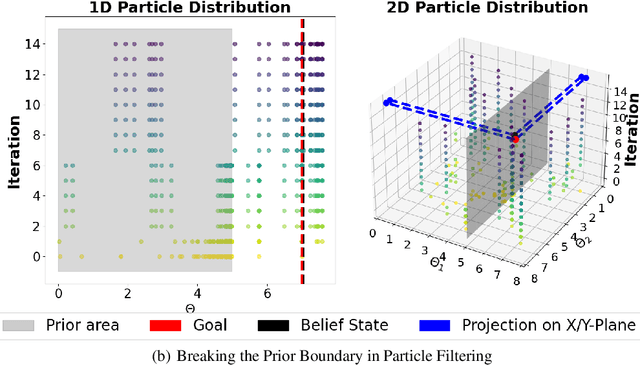
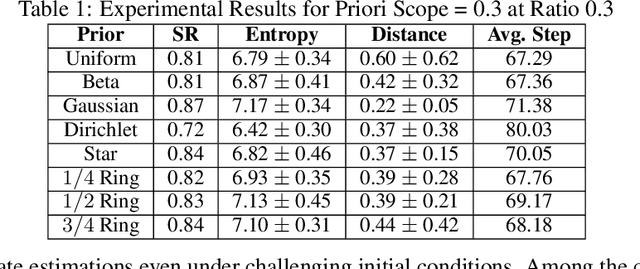
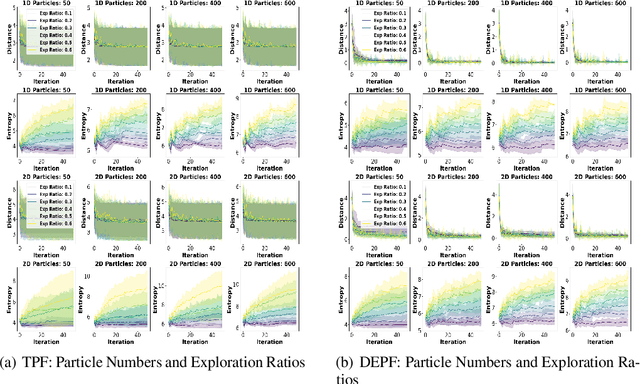
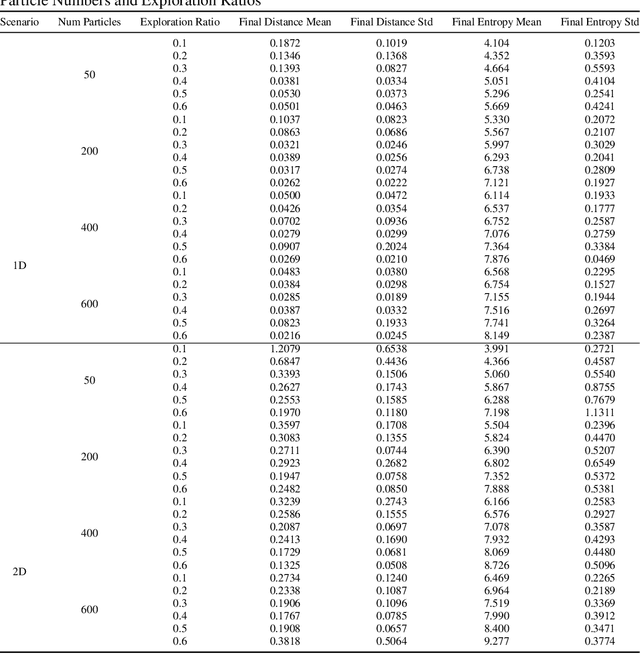
Abstract:Particle filtering is a Bayesian inference method and a fundamental tool in state estimation for dynamic systems, but its effectiveness is often limited by the constraints of the initial prior distribution, a phenomenon we define as the Prior Boundary Phenomenon. This challenge arises when target states lie outside the prior's support, rendering traditional particle filtering methods inadequate for accurate estimation. Although techniques like unbounded priors and larger particle sets have been proposed, they remain computationally prohibitive and lack adaptability in dynamic scenarios. To systematically overcome these limitations, we propose the Diffusion-Enhanced Particle Filtering Framework, which introduces three key innovations: adaptive diffusion through exploratory particles, entropy-driven regularisation to prevent weight collapse, and kernel-based perturbations for dynamic support expansion. These mechanisms collectively enable particle filtering to explore beyond prior boundaries, ensuring robust state estimation for out-of-boundary targets. Theoretical analysis and extensive experiments validate framework's effectiveness, indicating significant improvements in success rates and estimation accuracy across high-dimensional and non-convex scenarios.
Large Vision-Language Model Alignment and Misalignment: A Survey Through the Lens of Explainability
Jan 02, 2025Abstract:Large Vision-Language Models (LVLMs) have demonstrated remarkable capabilities in processing both visual and textual information. However, the critical challenge of alignment between visual and linguistic representations is not fully understood. This survey presents a comprehensive examination of alignment and misalignment in LVLMs through an explainability lens. We first examine the fundamentals of alignment, exploring its representational and behavioral aspects, training methodologies, and theoretical foundations. We then analyze misalignment phenomena across three semantic levels: object, attribute, and relational misalignment. Our investigation reveals that misalignment emerges from challenges at multiple levels: the data level, the model level, and the inference level. We provide a comprehensive review of existing mitigation strategies, categorizing them into parameter-frozen and parameter-tuning approaches. Finally, we outline promising future research directions, emphasizing the need for standardized evaluation protocols and in-depth explainability studies.
Towards Combating Frequency Simplicity-biased Learning for Domain Generalization
Oct 21, 2024Abstract:Domain generalization methods aim to learn transferable knowledge from source domains that can generalize well to unseen target domains. Recent studies show that neural networks frequently suffer from a simplicity-biased learning behavior which leads to over-reliance on specific frequency sets, namely as frequency shortcuts, instead of semantic information, resulting in poor generalization performance. Despite previous data augmentation techniques successfully enhancing generalization performances, they intend to apply more frequency shortcuts, thereby causing hallucinations of generalization improvement. In this paper, we aim to prevent such learning behavior of applying frequency shortcuts from a data-driven perspective. Given the theoretical justification of models' biased learning behavior on different spatial frequency components, which is based on the dataset frequency properties, we argue that the learning behavior on various frequency components could be manipulated by changing the dataset statistical structure in the Fourier domain. Intuitively, as frequency shortcuts are hidden in the dominant and highly dependent frequencies of dataset structure, dynamically perturbating the over-reliance frequency components could prevent the application of frequency shortcuts. To this end, we propose two effective data augmentation modules designed to collaboratively and adaptively adjust the frequency characteristic of the dataset, aiming to dynamically influence the learning behavior of the model and ultimately serving as a strategy to mitigate shortcut learning. Code is available at AdvFrequency (https://github.com/C0notSilly/AdvFrequency).
ProxiMix: Enhancing Fairness with Proximity Samples in Subgroups
Oct 02, 2024
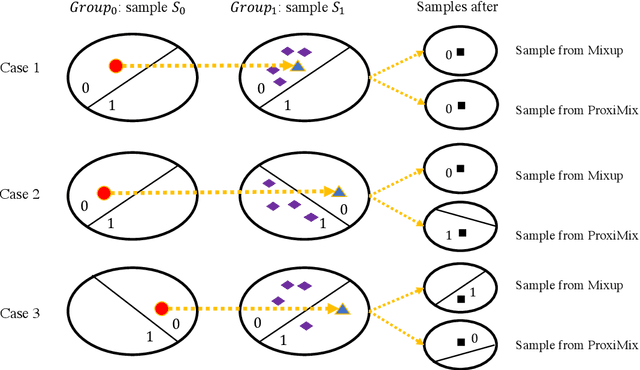


Abstract:Many bias mitigation methods have been developed for addressing fairness issues in machine learning. We found that using linear mixup alone, a data augmentation technique, for bias mitigation, can still retain biases present in dataset labels. Research presented in this paper aims to address this issue by proposing a novel pre-processing strategy in which both an existing mixup method and our new bias mitigation algorithm can be utilized to improve the generation of labels of augmented samples, which are proximity aware. Specifically, we proposed ProxiMix which keeps both pairwise and proximity relationships for fairer data augmentation. We conducted thorough experiments with three datasets, three ML models, and different hyperparameters settings. Our experimental results showed the effectiveness of ProxiMix from both fairness of predictions and fairness of recourse perspectives.
Strategic Demonstration Selection for Improved Fairness in LLM In-Context Learning
Aug 19, 2024Abstract:Recent studies highlight the effectiveness of using in-context learning (ICL) to steer large language models (LLMs) in processing tabular data, a challenging task given the structured nature of such data. Despite advancements in performance, the fairness implications of these methods are less understood. This study investigates how varying demonstrations within ICL prompts influence the fairness outcomes of LLMs. Our findings reveal that deliberately including minority group samples in prompts significantly boosts fairness without sacrificing predictive accuracy. Further experiments demonstrate that the proportion of minority to majority samples in demonstrations affects the trade-off between fairness and prediction accuracy. Based on these insights, we introduce a mitigation technique that employs clustering and evolutionary strategies to curate a diverse and representative sample set from the training data. This approach aims to enhance both predictive performance and fairness in ICL applications. Experimental results validate that our proposed method dramatically improves fairness across various metrics, showing its efficacy in real-world scenarios.
Interpretable Machine Learning for Weather and Climate Prediction: A Survey
Mar 24, 2024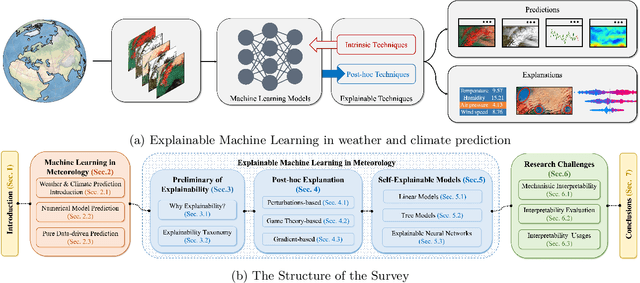

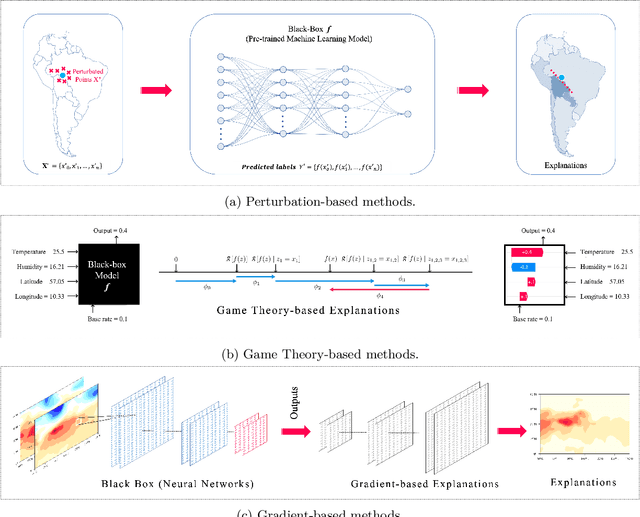
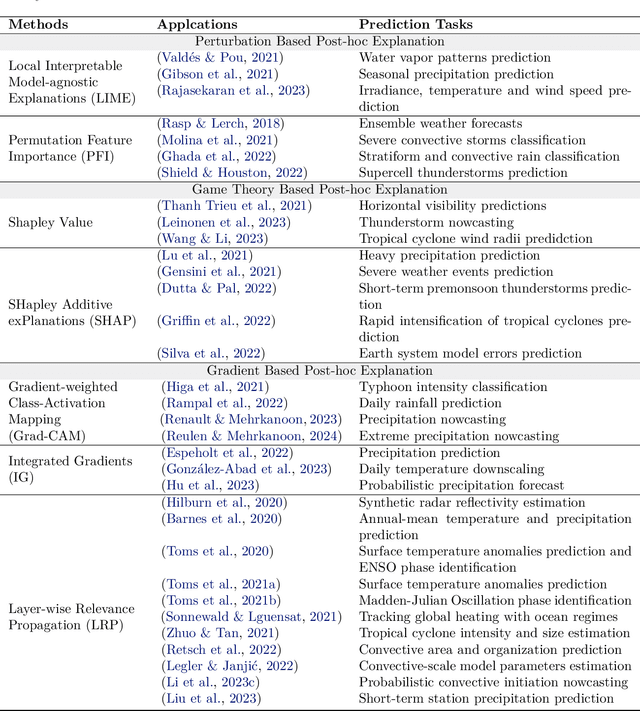
Abstract:Advanced machine learning models have recently achieved high predictive accuracy for weather and climate prediction. However, these complex models often lack inherent transparency and interpretability, acting as "black boxes" that impede user trust and hinder further model improvements. As such, interpretable machine learning techniques have become crucial in enhancing the credibility and utility of weather and climate modeling. In this survey, we review current interpretable machine learning approaches applied to meteorological predictions. We categorize methods into two major paradigms: 1) Post-hoc interpretability techniques that explain pre-trained models, such as perturbation-based, game theory based, and gradient-based attribution methods. 2) Designing inherently interpretable models from scratch using architectures like tree ensembles and explainable neural networks. We summarize how each technique provides insights into the predictions, uncovering novel meteorological relationships captured by machine learning. Lastly, we discuss research challenges around achieving deeper mechanistic interpretations aligned with physical principles, developing standardized evaluation benchmarks, integrating interpretability into iterative model development workflows, and providing explainability for large foundation models.
 Add to Chrome
Add to Chrome Add to Firefox
Add to Firefox Add to Edge
Add to Edge